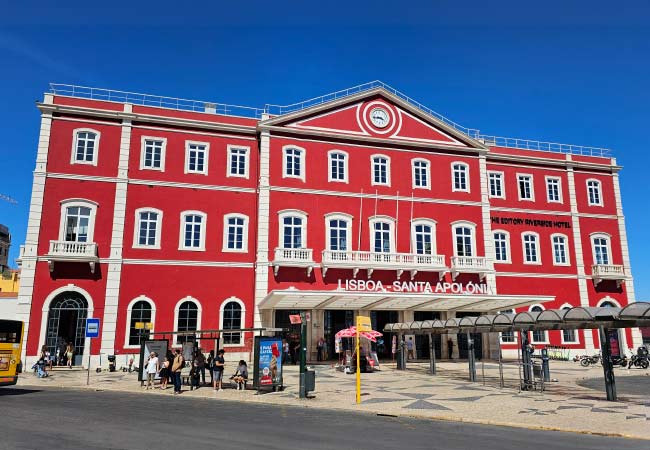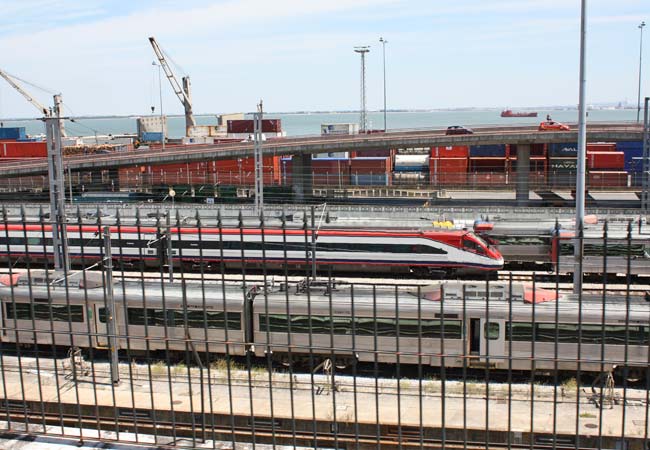LisbonLisboaPortugal.com
The best independent guide to Lisbon
LisbonLisboaPortugal.com
The best independent guide to Lisbon
Santa Apolónia train station, Lisbon
Santa Apolonia is one of the main train stations of Lisbon. The station is to the east of the historic centre and is positioned on a stretch of flat land between the Tejo Estuary and the hills of the Alfama district.
Santa Apolonia is the oldest train station in Lisbon, being constructed in 1865, and was initially envisaged as a grand terminus connecting European rail services with cruise liners heading across the Atlantic.
Today Santa Apolonia is a hassle-free station to pass through. There are only eight platforms, so it is easy to navigate around, there are good connections to Lisbon's public transport, and close by are the many shops and cafes of the Alfama district.
This article will provide an introduction to the Santa Apolonia train station and includes details of facilities, train services information and links to relevant information.
Note: The main train station of Lisbon is the Estação do Oriente, which is to the northeast of the city in the Parque das Nações district. Trains to Sintra depart from Rossio station, while rail services to Cascais and Estoril leave from the Cais do Sodré station.
Related articles: Estação do Oriente - Rossio station - Cais do Sodré station

Santa Apolonia station is painted a distinctive blue colour
Where is the Santa Apolónia station?
The Santa Apolonia station lies along the banks of the Tejo Estuary and is to the east of the historic centre (GPS: 38.71425, -9.12207). The station is next to the Museu Militar and is close to the "Terminal de Passageiros de Santa Apolónia" cruise terminal. Santa Apolonia station is connected to the metro network and is the final stop of the blue line.
It is possible to walk from the station to the historic centre of Lisbon; Praça do Comércio is 1.3km away, and Rossio plaza is 1.7km. For most tourists, the metro is the best way to travel to or from the station. Outside of the station is a taxi rank and there are local bus services.

An Alfa Pendular express train pulling into Santa Apolonia
Santa Apolónia metro station
Below the Santa Apolónia train station is the Santa Apolónia metro station, which is connected to the blue metro line. Santa Apolónia metro station is open from 6:30am to 1:00am, and a single fare costs €1.85 (which is charged to Navegante card).
Related articles: Lisbon metro guide
Train departures from Santa Apolónia
Intercity services
Santa Apolónia is the departure location for intercity train services that head to the north of Portugal, such as Coimbra, Aveiro, Porto, Braga and Guimarães. These trains are operated by Comboios de Portugal (CP), the national train operator of Portugal. The 2025 timetable of these services can be seen on their website:
www.cp.pt/
Tickets need to be purchased in advance of travel, and popular service do sell out. Tickets can be purchased from the CP website or from the ticket office in Santa Apolónia (open 06:00 to 21:45).
There are two types of express train; the Alfa Pendular and the Intercidades (Intercity). Alfa Pendular are faster service and use modern trains while the Intercidades are slightly slower (having more stops) and are cheaper. Train travel is inexpensive in Portugal, and we would always recommend travelling by the Alfa Pendular service.
Example fares include; Lisbon to Porto single costs, €31.70/€25.10 (Alfa Pendular/ Intercidades), Lisbon to Coimbra single €23.90/ €19.90(Alfa Pendular/ Intercidades) and Lisbon to Aveiro single cost €27.50/€21.00 (Alfa Pendular/ Intercidades).
Advice: There are many third-party booking websites for train travel, but it makes sense to purchase tickets directly from the CP website (https://www.cp.pt), as there are no booking fees. European railcards are very poor value in Portugal.
Useful side advice: Intercity train travel is the best way to travel to the major cities of Portugal, but the rail network is not that extensive and does not connect to many of the smaller towns. Where there are no intercity trains services, you will have to travel by coach. The main intercity bus company of Portugal is "Rede Expressos" and all of their services depart from the Sete Rios bus station.
Related articles: Sete Rios bus station
What about the intercity service to the south of Portugal?
The express train services to the south of Portugal (Faro and the Algarve) do not pass through the Santa Apolonia station; these services depart from the Estação do Oriente.
Express trains to the north of Portugal (mostly) depart from Santa Apolonia and then go through Estação do Oriente on the way northwards.
Estação do Oriente or Santa Apolonia?
If you are heading to the north of Portugal, most express services have the choice of Estação do Oriente or Santa Apolonia.
The Santa Apolonia is closer to the tourist districts of Baixa, Alfama and Chiado, and is a short walk or metro ride. The Estação do Oriente is much closer to the airport and is the better choice if you are arriving by air. Both stations are good for tourists; Santa Apolonia is a small station, while Estação do Oriente is much larger and more modern but, easy to travel through.
Warning: Always check the departure location as printed on your ticket
International train services
These trains have been suspended due to pandemic - please check the Comboios de Portugal for when they will be restarted.
Portugal has surprisingly few international train services and the only two departing are the Sud Expresso and the Lusitânia Comboio Hotel night trains. These two services are the same train from Lisbon and divide in central Spain, with the Lusitânia Comboio heading to Madrid, and the Sud Expresso travelling to Hendaye (northeast Spain), where there are connections to the French TGV network.
Note: It is possible to connect to the Sud/Lusitânia train at Coimbra, and here passengers from Porto connect to the service.
The timetable and prices can be seen on the CP website, but tickets are booked via the Renfe (Spanish train company website):
Note: The Gran Classe is worth the extra money as the Tourist Berths are very small and cramped. Always regard a night train as an experience and adventure (which it is), but never plan for a full night’s sleep, as it can be bumpy or noisy.
Urban trains from Santa Apolonia
Santa Apolonia is the departure location for the urban train service north to Azambuja. This route has very little interest to tourists, but it does connect the Santa Apolonia to the Estação do Oriente (but the metro is easier).
From Oriente, there is a train to Sintra, but the direct train from Rossio is a better choice. A full list of the departure from Santa Apolonia and the entire Azambuja urban route, please see:
www.cp.pt/
Facilities in Santa Apolonia Train Station
Santa Apolonia train station has the expected facilities of a medium-sized station; there is a café and shops, which includes a small Pingo Doce supermarket. As the station is on the edge of Alfama, there is a range of cafes, bars and shops within walking distance.
The station only has eight platforms, so it is very easy to navigate around and there is clear signage. The ticket office is open 06:00 to 21:45, and tickets for popular routes during the summer season should be booked well in advance. All tickets must be purchased before boarding the trains.
History of the Santa Apolonia Station
The station was built on the site of the old Santa Apolonia convent and was given the same name. The station was completed in 1865 and was based upon the traditional neoclassical style of the era, but the station more reflects a grand government department than a major train station.
The entire complex is 117 meters long, but as located between the hills of Alfama and the River Tejo it is only 25 meters wide.
The initial conception of the Estação de Santa Apolonia was to be the main hub as part of a major rail network that connected Europe by rail to America by ocean liner. The 1844 plans had the station set next to the River Tejo so that passengers could exit the station to board cruise liners bound for America and the pier was to be known as the America's Wharf.
The designs floundered, and building work was only begun in 1862 by a construction company called Oppermann and lead by the chief engineer João Evangelista de Abreu. The Estação de Santa Apolonia was inaugurated on May 1 of 1865, and direct train services to Madrid and the rest of Portugal soon followed.
The plans to connect Europe with American were never finalised, but the deep docks are in use today, as cruise ships bound for the Mediterranean make a first stop in Lisbon.
Discover more of Lisbon with our most popular guides
If you've found our content valuable, we'd welcome your support.
The digital publishing landscape has evolved significantly. As a small independent publisher, we face growing challenges. Search engines increasingly favour paid content over organic results, while AI-generated content often reproduces original work without attribution.
To support our work, please consider bookmarking this page (press Ctrl + D) for quick access. If you find an article helpful, we'd be grateful if you'd share it with friends on social media.
For specific questions, please see our Reddit community at r/LisbonPortugalTravel.
Should you notice any outdated or incorrect information, please contact us at [email protected]
Thank you for helping us continue to provide valuable content in an increasingly challenging digital environment.
A complete list of all of our Lisbon articles
If you've found our content valuable, we'd welcome your support.
The digital publishing landscape has evolved significantly. As a small independent publisher, we face growing challenges. Search engines increasingly favour paid content over organic results, while AI-generated content often reproduces original work without attribution.
To support our work, please consider bookmarking this page (press Ctrl + D) for quick access. If you find an article helpful, we'd be grateful if you'd share it with friends on social media.
For specific questions, please see our Reddit community at r/LisbonPortugalTravel.
Should you notice any outdated or incorrect information, please contact us at [email protected]
Thank you for helping us continue to provide valuable content in an increasingly challenging digital environment.































